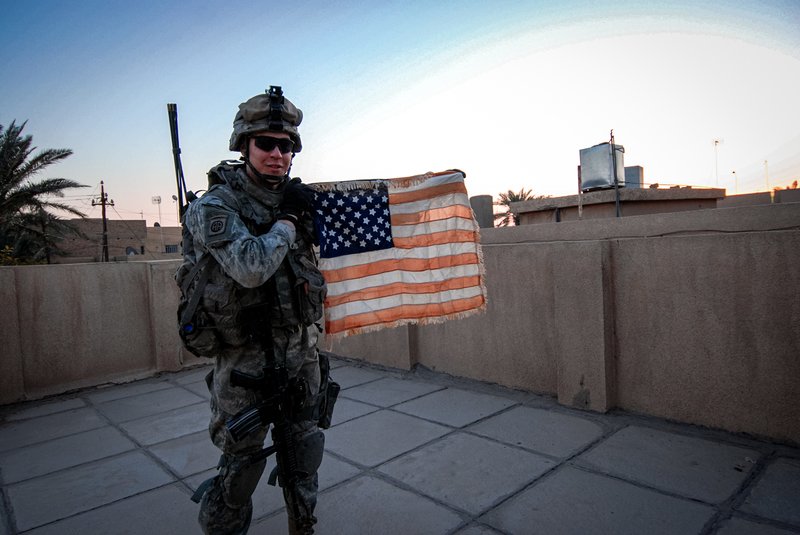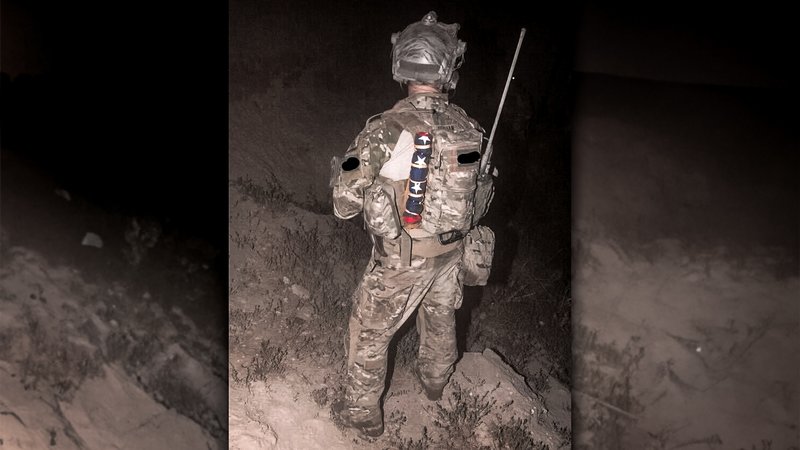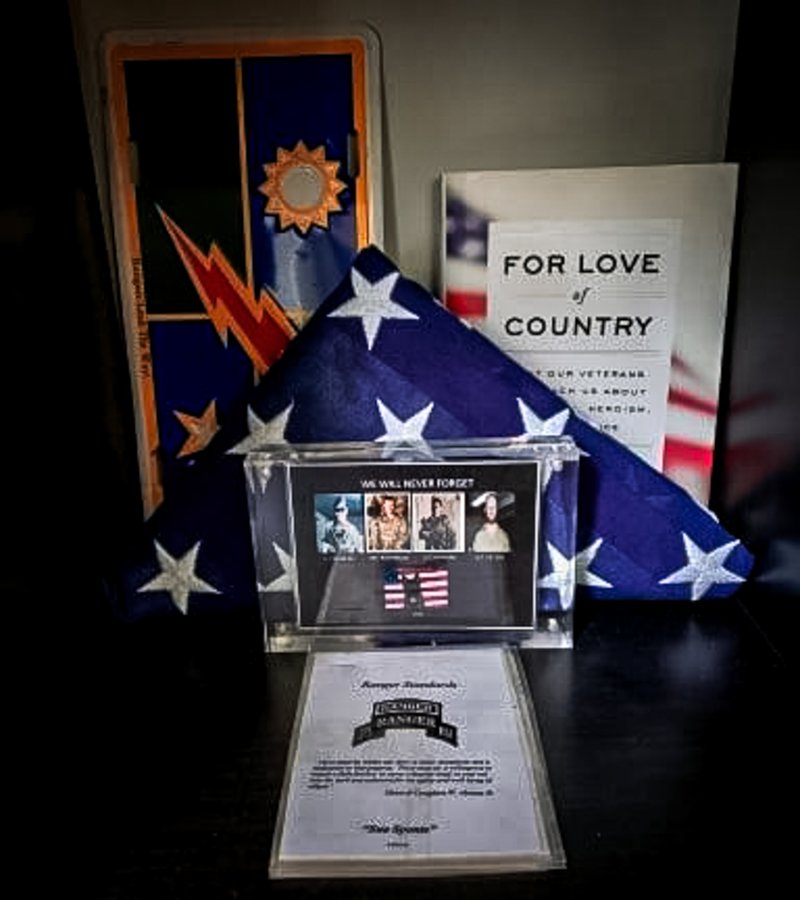
An Air Force pararescueman, assigned to the 83rd Expeditionary Rescue Squadron, displays the American flag on his kit during a training exercise at an undisclosed location in the mountains of Afghanistan, March 14, 2018. US Air Force photo by Tech. Sgt. Gregory Brook.
A 29-year-old Special Forces soldier pushes through an Afghan poppy field, carefully brushing aside the stalks as he travels under a night sky. His brothers-in-arms move silently behind him in a long line; the area is fraught with IEDs, and they still have a few more kilometers before they reach the target compound. Through his night vision, the soldier can see countless stars above him — more than could be seen by the naked eye. And on his back, there are a few more.
An American flag has been rolled up and secured with a couple of industrial rubber bands as well as knots of parachute cord to be safe. The red, white, and blue are tightly compacted together, attached to the Special Forces soldier’s back like it has been for his last five deployments.
There isn’t a well-defined term for this flag, but the tradition of carrying a rolled-up American flag into combat grew stronger throughout the Global War on Terror. Some call it a “kit flag” — the word “kit” being a common term for body armor.

Pfc. Alexander Cesario displays his father's American flag on a rooftop in Baghdad's Suleikh neighborhood, Dec. 27, 2007. As a soldier in Vietnam, the elder Cesario flew the flag daily — including a three-day period he was missing in action — and then his son carried it with him on patrols in Iraq. US Army photo by Staff Sgt. Michael Pryor.
Most service members who carry a kit flag use it as a keepsake. Our Special Forces soldier will take that flag home, frame it, and put it on his wall. Sometimes the flags are slightly tattered and dusty, sometimes they are practically pristine, and other times they bear shrapnel holes and stains of blood. But they always serve as a physical reminder — the symbol of the nation that sent them to war and all of the memories that flood back with it. Some of those memories are good, some are awful, and many are just mundane — all serve an important place in many veterans’ hearts.
Oftentimes, veterans feel they don’t need a keepsake. They might pass the flag to family, friends, or other important people in their lives who would appreciate it.
“I carried one each deployment to give to those who made a difference in my life outside of the military,” Alex Green, a former Army Ranger with four deployments to Afghanistan, told Coffee or Die. “Having been carried in a warzone, I hoped they would serve as a meaningful memento of our time overseas.”

Jariko Denman, a retired Army Ranger, carries a flag on his kit in combat. Despite its bright coloring, it hasn’t been a problem in giving away friendly positions. Photo courtesy of Jariko Denman.
When a service member is killed, if the flag is recoverable and it’s deemed appropriate, it may be given to family or close friends. If the flag isn’t given to the family, a fellow soldier might want it to remember their friend, even if they weren’t the type to carry a flag themselves.
There are other uses for these flags, too. Sometimes they are unraveled from the wearer’s kit and used as a daytime signal to indicate friendly forces. While this should be confirmed with other methods of communication, it can be a good, clear, and fast way to make it easy for an armed, nervous 19-year-old soldier to identify you. One of the first times Marine Corps veteran Carlo Shannon saw kit flags in use was during missions to recover downed aircraft.
“We didn’t know how the situation would escalate before we could reach a downed craft,” Shannon told Coffee or Die, “or if we were QRF [quick reaction force] for an element that was calling in WIA/KIA [wounded in action/killed in action].”
A kit flag can also be used to cover the body of someone who was killed in action during a mission, especially if the exfil is going to take a while, or to carry casualties. In 2013, I was a part of a Ranger platoon working in southeastern Afghanistan. Due to a complex IED ambush, we sustained significant casualties and began to run out of litters to carry out the dead and wounded. When our QRF arrived, there were still not enough litters for everyone. We eventually decided to use litters for the wounded and American flags to carry what was left of the dead so they could be returned home. It was a grim situation, but those who wore kit flags that night discovered a purpose for them beyond sentimentality.
Since it’s not an official military practice, there is no standard for “kit flags.” Some service members wrap flags around the plates inside their plate carriers. Others carry smaller, custom flags that they can fit in a small pouch. Most don’t carry any of these at all, and a few are entirely unfamiliar with the practice. It’s particularly common in the special operations community but is not universal in any unit.
Jonathan Blank, a 1st Marine Reconnaissance Battalion veteran, said he was unfamiliar with the practice entirely: “No one carried a flag on them … It wasn’t a thing really.”

A kit flag on display in a home. This was worn by Sgt. Patrick Hawkins, an Army Ranger killed in action in Afghanistan. Photo courtesy of the author.
“We saw the flags post-2010 more often,” Carlo Shannon told Coffee or Die. “I think if only because around that time, SOF was less spread out and there was more overlap in the Afghan theater. Being exposed to more of what other organizations were doing, we started seeing more traditions carrying across, regardless of branch. If it was more common before that time, I can’t say, I just know I rarely saw it before then.”
Throughout history, flags have been used as a form of both morale and command-and-signal. Prior to the radio or other modern forms of communication, massive formations would use flags to identify each other’s locations (among other practical uses). If you’re in the middle of a huge formation — an ocean of armored men clamoring against one another, literally tearing each other to pieces — seeing your flag continue to push forward could be a morale boost, literally meaning your group is taking ground. You’re winning.
According to the US Army Center of Military History, “Unit colors were a great source of pride, and victories or defeats were often expressed in terms of colors being captured from or lost to the enemy.”
From at least the Bronze Age through the 21st century, flags have had as much of a place in war as soldiers. They get dirty, torn, and sometimes destroyed, but, as Shannon notes, it’s “never seen as a disrespect to the flag.” The sanctity of the flag is not diminished by its time in combat; in fact, to many who wear it, it’s increased.
Read Next: From Factory to Fire: The Journey of an American Flag

Luke is the author of two war poetry books, The Gun and the Scythe and A Moment of Violence, and a post-apocalyptic novel, The First Marauder. He grew up in Pakistan and Thailand as the son of aid workers. Later, he served as an Army Ranger and deployed to Afghanistan on four combat deployments. Now he owns and operates Four Hawk Media, a social media-focused marketing company.
BRCC and Bad Moon Print Press team up for an exclusive, limited-edition T-shirt design!
BRCC partners with Team Room Design for an exclusive T-shirt release!
Thirty Seconds Out has partnered with BRCC for an exclusive shirt design invoking the God of Winter.
Lucas O'Hara of Grizzly Forge has teamed up with BRCC for a badass, exclusive Shirt Club T-shirt design featuring his most popular knife and tiomahawk.
Coffee or Die sits down with one of the graphic designers behind Black Rifle Coffee's signature look and vibe.
Biden will award the Medal of Honor to a Vietnam War Army helicopter pilot who risked his life to save a reconnaissance team from almost certain death.
Ever wonder how much Jack Mandaville would f*ck sh*t up if he went back in time? The American Revolution didn't even see him coming.
A nearly 200-year-old West Point time capsule that at first appeared to yield little more than dust contains hidden treasure, the US Military Academy said.












